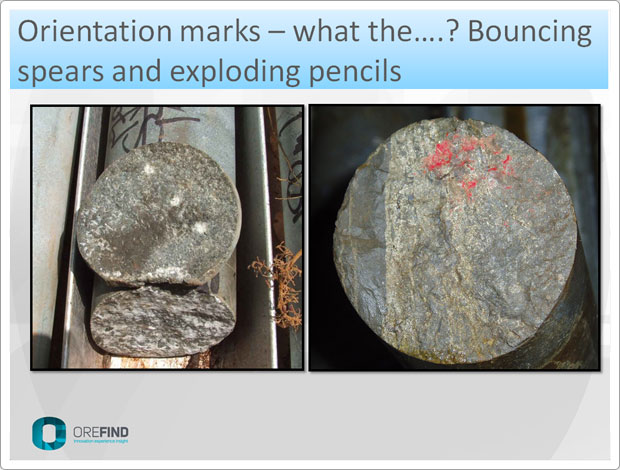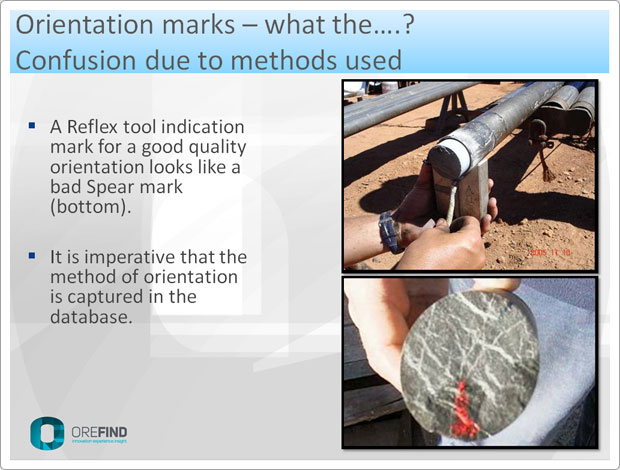The PowerPoint presentation* on our website identifies many of the issues that are alarmingly common in the mineral exploration and mining business. The presentation was given at the recent AIG Structural Geology and Resources 2012 Symposium. The feedback from the attendees could be construed as both good and bad. It is always great to get positive response but, unfortunately, much of this stemmed from the fact that most people in the audience had less than favourable stories to tell about their own experiences with core orientation. This is the first of three blog posts on the subject of drill core orientation.
Drill core orientation – comments on methods
Many of the problems are a function of inexperience in dealing with core orientation methods at the front-end, lack of care and knowledge during the mark-up process, and deficient geological manipulation and interrogation of data at the collection and interpretation stages. Many of these problems are commonly amplified by ineffective dialogue between the geologists and drillers, followed by a less than professional approach to management of the whole process.
A detailed description of all the available core orientation methods currently in use was beyond the scope of a presentation at the symposium and is, likewise, beyond the length of a single post. Rather, some comments will be made here in a series of three blog posts regarding the methods of core orientation and will address issues with them.
Methods of drill core orientation
Down-hole survey data provides the plunge and plunge-direction (azimuth) of the axis of the core. However, additional mechanical/digital devices are required to provide information to fully orientate the cylinder of core. These methods determine the orientation of the face of core at the drilling break between core runs and the most common methods include the down-hole spear, Ezy-Mark and Ballmark and Reflex systems.
Industry standard appears to be phasing out the use of the spear because it is generally considered less accurate than these newer methods. However, the spear method is still very common and many of the problems encountered are not a product of the method but rather result from poor techniques at some, or all, of the stages from orientation to mark-up.
Potential problems with the methods
The spear
The spear orientation method is the simplest for orienting core and, when done properly, can yield accurate and consistent data. It consists of a lowering a heavy steel spear with a sharp point or a wax-pencil tip on a wire-line inside the drill rods after the inner tube is removed. The spear hits the bottom of the hole producing a mark on the next piece of rock to be cored. The heavy spear slides along the bottom of the rods and the mark or chip on the core will identify the bottom edge of the core. Good quality spear orientation marks will occur as discrete marks near the edge of the core.
Although the spear orientation device is very simple, several problems can arise, including:
- The drill-bit may not be on the bottom of the hole
- The tip must be firmly screwed into the spear to prevent it and the spear from bending. A bent spear tip will produce inaccurate results.
- The tip of the spear should be a sharp taper. A thick nut or some other holder for the tungsten tip or crayon will result in the mark being too far in from the edge of the core.
- The spear should be lowered so that it produces a single punch mark. If it is lowered too slowly it will fail to produce a mark and if it is lowered too fast the spear may bounce producing multiple marks or streaked lines. The correct speed will be dependent on the angle of the hole and the hardness of the rock and can only be determined by trial and error.
- The angle of the hole may be too great or too low. Best results are obtained in drill holes with plunges between 35° and 75°. The depth of the hole should not significantly affect the quality of the marks.
 Examples of bad spear markings due to dropping the spear from too high up the hole. Bouncing spear (LEFT) and diffuse marking caused by 'exploding pencil' (RIGHT). Get the full PowerPoint (converted to PDF) if you are registered with Orefind.com.
Examples of bad spear markings due to dropping the spear from too high up the hole. Bouncing spear (LEFT) and diffuse marking caused by 'exploding pencil' (RIGHT). Get the full PowerPoint (converted to PDF) if you are registered with Orefind.com.
Ballmark®
The Ballmark system relies on punching an aluminium washer with a ball that revolves under the influence of gravity. This mark represents the bottom of hole and the orientation relative to reference mark gives the location of the bottom of hole orientation line. Errors can occur if the aluminium washer is punched too soon i.e. before the ball has stopped revolving in the hole. In some cases two indents can be produced on the same washer. This can be due to lowering the rods too quickly, causing compression of the spring when the rods hit the bottom of the hole.
Ezy-MarkTM
The presence of factors such as a water table must be considered in holes when using the Ezy-Mark as these can cause the device to fire prematurely before they contact the broken face on which the orientation mark needs to be made.
ReflexTM
The Reflex tool is by far the most sophisticated in terms of its inner working, comprising digital read-outs, internal silicon accelerometers, and electronics and represents an evolution from the Ace tool. In the past, instruments such as the Ace tool were returned to surface on completion of the drilling run and the user entered the time at which the core was broken based on a readout on a stopwatch. The tool recalled the associated accelerometer information for the same time period from its memory and then guided the user to position the tool and core barrel so that the same low side position was reproduced on the surface.
The marking of the orientation obtained from the Ace tool was originally prone to error because it relied on accurate measurement of the amount of time from when the reading was taken relative to when the rods were lowered. This potential area for error has been rectified in the Reflex instruments and stopwatches are no longer required as the instrument automatically records time and date. LED lights and an audible signal now compliment the LCD screen to direct the operator towards the correct orientation alignment.
Using a jig provided with the Reflex tool, the core is marked at the lifter case end of the sample. Although the mark should be made on the end of the core it is common for drillers to put the orientation mark on the outside of the core, which is then removed when the core is slid out of the barrel. Significant errors are induced when the drillers then attempt to determine where the mark was.
An additional issue that seemed to affect the electronic tools was extreme cold. We have worked on projects in northern Canada where the instruments simply could not reproduce consecutive measurements.
A final point worth noting is that good marks can be interpreted as unreliable if there is no indication of the method of core orientation used. Drillers using the Reflex tool commonly put an elongate mark on the end of the core that projects to the core margin. These elongate marks associated with orientation of core via the Reflext tool can look like badly smeared spear marks. For this reason, it is imperative that the method of core orientation be recorded in the database.

A Reflex mark can be confused with a bad spear mark. Get the full PowerPoint (converted to PDF) if you are registered with Orefind.com
General problems
A general problem that is inherent in many drilling campaigns is the inexperience of the geologist or the driller or both. This can result in generally poor results and can affect factors as simple as when the orientation mark is made. Generally, the capture of an orientation by the driller is factored into the contract, typically within the metre rate. I have seen examples where an orientation charge has been agreed upon and the drillers have then proceeded to take orientations every 40m or more. This is unacceptable and was the fault of the geologist not checking the frequency of orientation marks and the drilling foreman not adhering to the agreement.
The next post will look at Potential Solutions to Poor Drill Core Orientation at the Rig.
* To download the accompanying PDF, you must be
registered with Orefind.com.
Our next post:
One small click by You, one huge leap for geological understanding